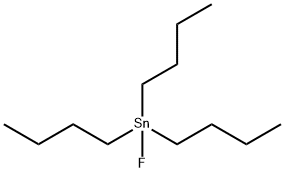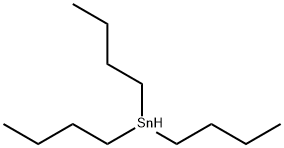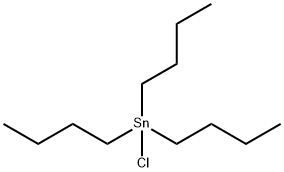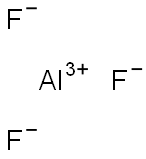Fluorotributyltin
- CAS NO.:1983-10-4
- Empirical Formula: C12H27FSn
- Molecular Weight: 309.05
- MDL number: MFCD00013547
- EINECS: 217-847-9
- SAFETY DATA SHEET (SDS)
- Update Date: 2023-04-23 13:52:06

What is Fluorotributyltin?
The Uses of Fluorotributyltin
Tri-n-butyltin fluoride is a reagent used for the selective desilylation of bis(silyl) enol ethers. It is also used as antifoulant for marine paints; reagent.
General Description
A liquid.
Reactivity Profile
Fluorotributyltin is in the family of tin compounds widely used as stabilizers for plastics, additives to paint(as antifouling agents). Some have catalytic properties. Examples include butyl tin, dibutyl tin oxide. Their main hazard is associated with their high toxicity, in skin adsorption or inhalation. Fluorotributyltin is incompatible with strong oxidizers like: ammonium nitrate, barium nitrate, barium chlorate, etc.
Safety Profile
Poison by ingestion. Many tributyl tin compounds are hghly toxic to marine life. Mutation data reported.When heated to decomposition it emits toxic fumes of F-. See also TIN COMPOUNDS and FLUORIDES.
Properties of Fluorotributyltin
| Melting point: | 269-271 °C(lit.) |
| Boiling point: | 285°C (rough estimate) |
| Density | 1,28 g/cm3 |
| Flash point: | >150°C |
| Specific Gravity | 1.28 |
| Water Solubility | Soluble in nonpolar organic solvents. Insoluble in water. |
| Sensitive | Moisture Sensitive |
| Exposure limits | ACGIH: TWA 0.1 mg/m3; STEL 0.2 mg/m3 (Skin) NIOSH: IDLH 25 mg/m3; TWA 0.1 mg/m3 |
| CAS DataBase Reference | 1983-10-4(CAS DataBase Reference) |
| EPA Substance Registry System | Tributyltin fluoride (1983-10-4) |
Safety information for Fluorotributyltin
| Signal word | Danger |
| Pictogram(s) |
 Skull and Crossbones Acute Toxicity GHS06  Health Hazard GHS08  Environment GHS09 |
| GHS Hazard Statements |
H301:Acute toxicity,oral H312:Acute toxicity,dermal H315:Skin corrosion/irritation H319:Serious eye damage/eye irritation H372:Specific target organ toxicity, repeated exposure H400:Hazardous to the aquatic environment, acute hazard H410:Hazardous to the aquatic environment, long-term hazard |
| Precautionary Statement Codes |
P260:Do not breathe dust/fume/gas/mist/vapours/spray. P273:Avoid release to the environment. P280:Wear protective gloves/protective clothing/eye protection/face protection. P314:Get medical advice/attention if you feel unwell. P391:Collect spillage. Hazardous to the aquatic environment P305+P351+P338:IF IN EYES: Rinse cautiously with water for several minutes. Remove contact lenses, if present and easy to do. Continuerinsing. P337+P313:IF eye irritation persists: Get medical advice/attention. P405:Store locked up. |
Computed Descriptors for Fluorotributyltin
New Products
4-AMINO-TETRAHYDRO-PYRAN-4-CARBOXYLIC ACID HCL 4-(Dimethylamino)tetrahydro-2H-pyran-4-carbonitrile 4-Aminotetrahydropyran-4-carbonitrile Hydrochloride (R)-3-Aminobutanenitrile Hydrochloride 3-((Dimethylamino)methyl)-5-methylhexan-2-one oxalate 1,4-Dioxa-8-azaspiro[4.5]decane 5-Bromo-2-nitropyridine Nimesulide BP Aceclofenac IP/BP/EP Diclofenac Sodium IP/BP/EP/USP Mefenamic Acid IP/BP/EP/USP Ornidazole IP Diclofenac Potassium THOMAIND PAPER PH 2.0 TO 4.5 1 BOX BUFFER CAPSULE PH 9.2 - 10 CAP SODIUM CHLORIDE 0.1N CVS ALLOXAN MONOHYDRATE 98% PLATINUM 0.5% ON 3 MM ALUMINA PELLETS (TYPE 73) LITHIUM AAS SOLUTION 2-Bromo-1-(bromomethyl)-3-chloro-5-nitrobenzene 2-Bromo-3-nitroaniline N-(3-Hydroxypropyl)-N-methylacetamide 3-Bromo-6-chloropyridazine 4-ethyl-3-nitrobenzoic acidRelated products of tetrahydrofuran








You may like
-
 Tri-n-butyltin fluoride 98% (GC) CAS 1983-10-4View Details
Tri-n-butyltin fluoride 98% (GC) CAS 1983-10-4View Details
1983-10-4 -
 Fluorotributyltin 95% CAS 1983-10-4View Details
Fluorotributyltin 95% CAS 1983-10-4View Details
1983-10-4 -
 1823368-42-8 98%View Details
1823368-42-8 98%View Details
1823368-42-8 -
 2-(3-(tert-butyl)phenoxy)-2-methylpropanoic acid 1307449-08-6 98%View Details
2-(3-(tert-butyl)phenoxy)-2-methylpropanoic acid 1307449-08-6 98%View Details
1307449-08-6 -
 Ethyl 3-(furan-2-yl)-3-hydroxypropanoate 25408-95-1 98%View Details
Ethyl 3-(furan-2-yl)-3-hydroxypropanoate 25408-95-1 98%View Details
25408-95-1 -
 2-Chloro-5-fluoro-1-methoxy-3-methylbenzene 98%View Details
2-Chloro-5-fluoro-1-methoxy-3-methylbenzene 98%View Details
1805639-70-6 -
 1784294-80-9 98%View Details
1784294-80-9 98%View Details
1784294-80-9 -
 Lithium ClavulanateView Details
Lithium ClavulanateView Details
61177-44-4